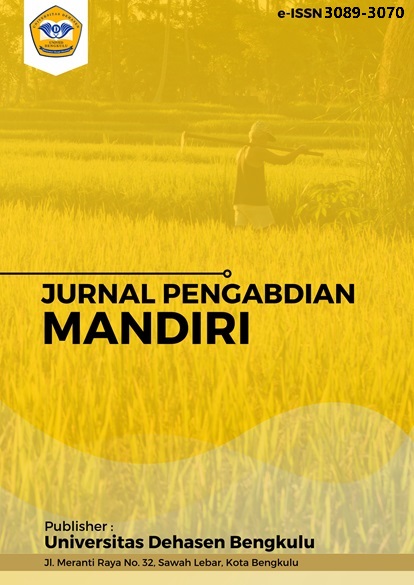Analysis Of Risk Factors Affecting Hypertension Disease In The Jayaloka Village Area, Empat Lawang Regency
DOI:
https://doi.org/10.70963/mandiri.v2i1.657Keywords:
Hypertension, Risk factors, Prevalence, Prevention, Healthy lifestyleAbstract
Hypertension, or high blood pressure, is one of the leading causes of death and disability worldwide. This disease has become a growing global health problem, especially in developing countries, including Indonesia. Hypertension often shows no symptoms in its early stages, earning it the nickname "silent killer." This study aims to identify the main risk factors contributing to hypertension in urban communities and evaluate strategies for its management.This research employed a quantitative approach with a cross-sectional study design, involving respondents aged 30-65 years residing in the Jayaloka subdistrict. Data were collected through structured interviews and blood pressure measurements using a digital sphygmomanometer. Statistical analysis was conducted to determine the relationship between risk factors such as smoking habits, excessive salt consumption, lack of physical activity, obesity, and family history of hypertension.The results showed that 40% of respondents experienced hypertension, with a higher prevalence in the age group above 50 years. The main risk factors significantly associated with hypertension were obesity (p < 0.05), high salt consumption (p < 0.05), and a family history of hypertension (p < 0.01). Management strategies involving lifestyle modifications such as a low-salt diet, increased physical activity, and health education proved effective in reducing blood pressure among individuals with mild to moderate hypertension. This study concludes that hypertension can be prevented and managed through a combination of promotive and preventive efforts. Therefore, community health interventions focusing on controlling major risk factors are essential to reduce the burden of hypertension in the Jayaloka subdistrict
References
Al-Safi, S. A., & Aboul-Enein, B. H. (2021). Physical activity and hypertension management. International Journal of Hypertension, 2021, 1–8. https://doi.org/10.1155/2021/8899764
Chen, X., Wang, Y., & Wang, J. (2022). Salt intake and hypertension: A global health perspective. Journal of Human Hypertension, 36(2), 105–112. https://doi.org/10.1038/s41371-021-00588-1
Mills, K. T., Stefanescu, A., & He, J. (2020). The global epidemiology of hypertension. Nature Reviews Nephrology, 16(4), 223–237. https://doi.org/10.1038/s41581-019-0244-2
Whelton, P. K., Carey, R. M., Aronow, W. S., Casey, D. E., Collins, K. J., & Himmelfarb, C. D. (2018). 2017 ACC/AHA guideline for the prevention, detection, evaluation, and management of high blood pressure in adults. Journal of the American College of Cardiology, 71(19), e127–e248. https://doi.org/10.1016/j.jacc.2017.11.006
WHO. (2020). Guidelines on sodium intake for adults and children. Retrieved from https://apps.who.int
World Health Organization. (2021). Hypertension. Retrieved from https://www.who.int
Kementerian Kesehatan Republik Indonesia. (2018). Laporan Nasional Riset Kesehatan Dasar (Riskesdas) 2018. Jakarta: Badan Penelitian dan Pengembangan Kesehatan.
Downloads
Published
How to Cite
Issue
Section
License
Copyright (c) 2025 Elvira Eka Agustina, Melda Andriani , Suci Wulandari, Aprilia Kartini, Winda Puspa Sari , Delta Aprianti, Tuti Rohani, Danur az

This work is licensed under a Creative Commons Attribution-ShareAlike 4.0 International License.





